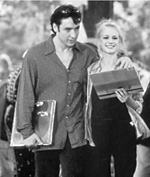For the last two years, recent design graduate Amy Patrick has worked with the Nordstrom Product Group, creating technical drawings and product packets for numerous buyer meetings. Though she started as a fashion marketing major and continued as an intern with the popular department store’s junior clothing line, Patrick has consistently streamlined her expertise to focus on the oft-misunderstood back end of apparel design: fabric engineering.
While many fashion fanatics just want to know if hems this fall are highwater or low tide, Patrick has to preface trends by spending hours at a PC in order to break down the basic foundations of the finished product. Anything from evening gowns, men’s shirts, and fuzzy sweaters are first skewered on a monitor, where designers must develop patterns and lines. Her heavy emphasis on the technical aspects of design—using software like Corel Draw and Vision Weave to create fabric swatches and textile catalogs—is almost intimidating.
Not so with Patrick’s portfolio, a swank collection of flowing lines and polished fabrics. Long skirts welcome lanky and voluptuous shapes alike, dragging the eye downward to silvery ripples of material, while a sleeveless shorter dress swoops away from the hips in a geometric snap. Though the hues tend to be more evening friendly, the classic look of the smooth skirts are perfect for women who have zero time between the office and the martini bar. Patrick’s doctrine emphasizes “clean, modern design, balanced with asymmetries and ethereal color,” but what one really gains from eyeballing her line is the sense that she has achieved an often elusive goal: blending the severity of functional demands with the soft edges of daydreams.
BEN SEVILLA
After serving time as a salesman for casual clothing franchises like the Gap and Banana Republic, designer Ben Sevilla learned all areas of running a retail store. He punched the register keys, took inventory, and set up store displays. In the meantime, Sevilla attended fashion design classes that taught him to do custom fittings and alterations. Those classroom hours have since been applied with his jobs at local upscale boutiques like Carol McClellan, where he specializes in leather and formalwear.
As a designer, Sevilla’s focus is on not only practicality, but redefining modernism. He alters patterns to fit the architecture of the age, and strives to find contrast in each piece. Through the use of his pattern making and acquired design skills, Sevilla continues to make progress in specialty tailoring.
TOBY WEAVER
If Audrey Hepburn lived in the year 2001, she’d want Toby Garrett Weaver to design her wardrobe. The designer’s portfolio is rife with touches of gauzy fabric, slim bodices, and chopstick lines—all favorites of yore. But atop the filmy sleeves are android overlaps where buttons should be, paired with deliciously thick streetwear layers and mod-Dracula collars. Weaver’s goal for his womenswear line? To create “evening wear inspired by a deconstructed vision of 16th-century England,” while retaining a healthy amount of practicality.
HELEN MOON
Helen Moon strives to design edgy sportswear that (unlike many trend-setting pieces) retains its functionality and affordability. “It’s meant to be very wearable,” she says. “I’m really interested in using odd fabric.” Her modern line includes pieces made from powermesh—textile that is used to make bathing suits—and kite material, resulting in geometric shapes that also breathe. She also designs sporty bags to fit her angular clothing designs. The entire collection is priced in a reasonable range and ready to wear.
After graduating from the Seattle Central apparel design program, Moon feels she is ready to take on a full-time design assistant position. “That’s where most of us [design graduates] get our start,” she explains. “I realized when I was working at a clothing company a few years ago that I needed more technical experience to pull off the creative aspect of design.” Now, Moon and her classmates spend the last 11 weeks of their courses on a computer, flat sketching patterns and constructing the ideas in their heads.
“It’s really intense and fast-paced, but it’s so professional,” says the designer. “For my final showing, I had the makeup, hair and fitting done, just like a professional photo shoot. It was exactly what I’d wanted.” The feedback on Moon’s alternative sportswear has been positive; she attributes that to her extensive technical training. Fabric may not be a science to many, but it’s essential to young designers: “You can’t get to where you want to be creatively if you don’t have the computer skills,” Moon warns.






